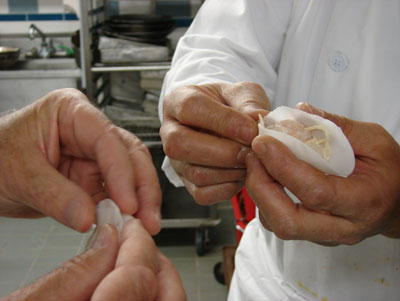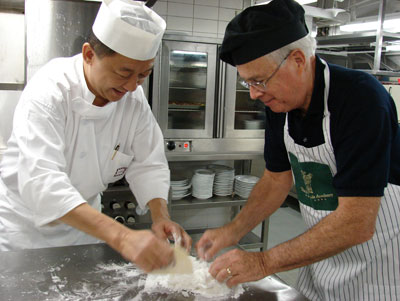What’s cooking in Hong Kong?
This item appears on page 58 of the September 2010 issue.
by Sandra Scott
Dim sum is uniquely Chinese. Consisting of a variety of dumplings and other items usually served in individual bamboo steamers, it could be equated to hors d’oeuvres, and when several are ordered they make a wonderful meal.
Dim sum translates to “touch your heart.” My husband, John, and I were introduced to dim sum in Hong Kong several years ago. A friend took us to a dim sum restaurant where a wheeled cart with a variety of dim sum choices went from table to table so diners could pick what they wanted. A picture menu showed the different choices, so when the cart arrived at our table we pointed out the dim sum we wanted.
The history of dim sum was on the back of the menu. It seems that a demanding empress ordered her royal chef to prepare a special meal for her. Afraid to make a mistake, the chef made many individual items sure to “touch her heart.”
Dim sum was a success and became popular with travelers journeying along the famous Silk Road. They needed a place to rest, so teahouses opened up along the roadside. After a while, to accompany the tea, teahouse proprietors began adding a variety of snacks in the form of dim sum.
In April ’09, on another trip to Hong Kong, John and I stayed in Kowloon at The Peninsula (from the US, call 800/262-9467, www.peninsula.com). I mentioned to a member of the hotel staff that we wanted to take a cooking lesson. The staff person told us that, while they offer dim sum classes, there were none scheduled during our stay. However, noting my disappointment, she added, “I am sure our chef would love to show you how to make dim sum.”
The next morning we met Chef Wah in the hotel’s kitchen, where he taught us how to make shrimp dim sum.
Chef Wah explained, “No matter where you go in the world, shrimp dim sum has a pure style. It always has the same ingredients and shape.”
We found shaping the purse-like dumplings more difficult than it looked, but, as Chef Wah said, “It takes practice. I make 400 to 500 every day.”
We did not pay for our impromptu lesson, but The Peninsula offers half-day dim sum classes to both guests and nonguests at a cost of $140 per person, which includes lunch in the hotel’s Spring Moon Restaurant.
The best way to make arrangements for a dim sum cooking class is to call the toll-free number from the US or, when in Hong Kong, dial the hotel directly (853 2920 2888).
A standard room at The Peninsula, rated one of the top accommodations in the world, costs $400-$500 per night, depending on the season and rate of exchange.
1 tsp powdered chicken stock
¼ tsp sugar
¼ tsp sesame oil
6 ounces finely minced shrimp
½ cup finely chopped bamboo shoots
¼ tsp salt
(It is possible to buy wrappers.)
2 cups wheat flour
3 tbsp cornstarch
1¾ cups boiling water


